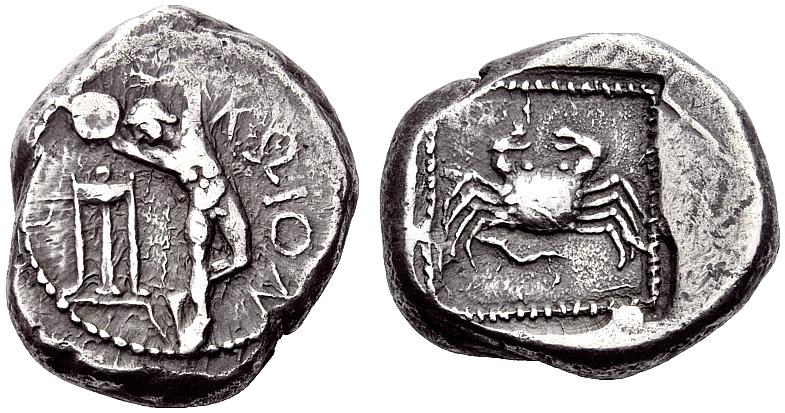SO 1478 - Cos over uncertain mint
From SILVER
| Line 18: | Line 18: | ||
|Standard=Persic | |Standard=Persic | ||
|Coin reference=Babelon 1910, 1740 and pl. CCCLXVIII 13. ; Boston 2016 ; BMC Crete, n°9 ; Kunstfreund 165 | |Coin reference=Babelon 1910, 1740 and pl. CCCLXVIII 13. ; Boston 2016 ; BMC Crete, n°9 ; Kunstfreund 165 | ||
| − | |Coin series reference=BMC Crete, n°9; Babelon | + | |Coin series reference=BMC Crete, n°9; Babelon 1901-1932, Tome 2, Part 2; Barron 1968, Group B, n°13-18; HGC 6, n°1299 |
|Coin series web reference=https://greekcoinage.org/iris/id/cos_stefanaki_2012_3.6 | |Coin series web reference=https://greekcoinage.org/iris/id/cos_stefanaki_2012_3.6 | ||
}} | }} | ||
Latest revision as of 13:39, 16 May 2024
480 BCE - 475 BCEΚΩΙΟΝ
Images
Overstriking coin

Cos_NAC_627.jpg [1]
Location/history
| Sale(s)Sale(s) ᵖ: | Numismatica Ars Classica 59, 4 Apr. 2011, n°627= Triton 12, 2009, n°328 = Numismatica Ars Classica 2, 1990, n°200 = Leu-M&M 28, May 1974, Kunstfreund n°165 = Schlessinger 13,1935 = Hermitage, n°1336 | |
| Private collection(s)Private collection(s) ᵖ: | W. B. R Montgomery collection ; Gillet collection |
Overstriking coin
Description
| ObverseInscription or printing placed on the obverse.: | ΚΩΙΟΝ (Greek) Discobolus about to hurl disc. In left field, tripod. Border of dot. | ReverseInscription or printing placed on the reverse.: | Crab within incuse square with dotted borders. |
Mint and issuing power
| MintIdentifies the place of manufacture or issue of a numismatic object.: | Cos | Ancient regionAncient region. | Caria | Modern countryModern country: Greece | AuthorityIdentifies the issuing power. The authority can be "pretended" when the name or the portrait of X is on the coin but he/she was not the issuing power. It can also be "uncertain" when there is no mention of X on the coin but he/she was the issuing power according to the historical sources: |
Chronology
| FromIdentifies the initial date in a range assigned in a numismatic context. 480 BCE toIdentifies the final date in a range assigned in a numismatic context.. 475 BCE | Classical 480-323 BC |
Physical description
| MetalThe physical material (usually metal) from which an object is made.: Silver |
WeightWeight of the numismatic object (in grams). in grams: 16.4816.48 g <br />16,480 mg <br /> | DenominationTerm indicating the value of a numismatic object. Examples: tetradrachm, chalkous, denarius.: triple siglos |
|
| StandardStandard.: Persic | |||
References
| Coin referenceReference of the Coin: | Babelon 1910, 1740 and pl. CCCLXVIII 13., Boston 2016, BMC Crete, n°9, Kunstfreund 165 | Coin series referenceReference to coin series study: | BMC Crete1BMC Crete, n°9, Babelon 1901-19322Babelon 1901-1932, Tome 2, Part 2, Barron 19683Barron 1968, Group B, n°13-18, HGC 64HGC 6, n°1299 |
| Coin series web referenceCoin series web references: | |||
Overstruck type
Description
| ObverseInscription or printing placed on the obverse.: | ReverseInscription or printing placed on the reverse.: |
Mint and issuing power
| MintIdentifies the place of manufacture or issue of a numismatic object. ᵖ: | Ancient regionAncient region. ᵖ | Modern countryModern country: | AuthorityIdentifies the authority in whose name (explicitly or implicitly) a numismatic object was issued. ᵖ: |
Chronology
| FromIdentifies the initial date in a range assigned in a numismatic context. toIdentifies the final date in a range assigned in a numismatic context.. | periodTime period of the numismatic object. |
Physical description
References
| Coin type referenceReference to coin series study ᵖ: |
Additional data
| Frequency of overstrikesFrequency of overstrikes: | Level of confidenceLevel of confidence of the identification: | ||
| RemarksRemarks: | |||
References
- ^ Wroth, Warwick William (1886), A Catalogue of the Greek coins in the British Museum. vol. X : Crete and the Aegean Islands, London, The Trustees, p. 152, pl. XXIX
- ^ Babelon, Ernest (1901-1932), Traité des monnaies grecques et romaines, Paris, E. Leroux
- ^ Barron, John Penrose (1968), "The Fifth-Century Diskoboloi of Kos", in Colin M. Kraay and Gilbert Kenneth Jenkins (éd.), Essays in Greek Coinage Presented to Stanley Robinson, Oxford, p. 75-89, pl. 8-10.
- ^ Hoover, Oliver D. (2010), The Handbook of Greek Coinage Series, volume 6 : handbook of coins of the islands: Adriatic, Iionian, Thracian, Aegean, and Carpathian seas (excluding Crete and Cyprus), sixth to first centuries BC, Lancaster, 358 p.